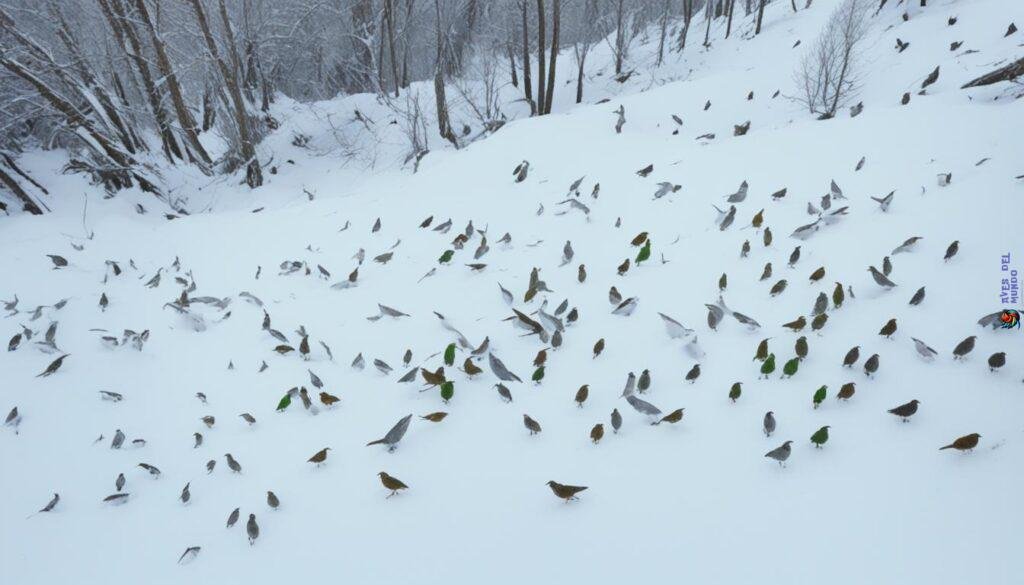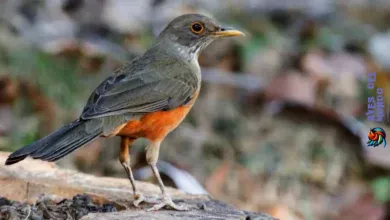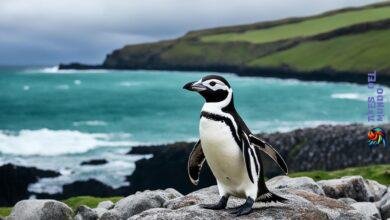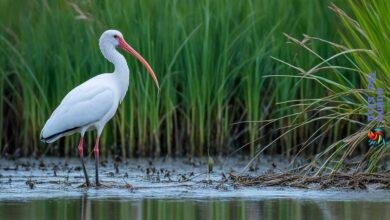Did you know that snowy owls are one of the most iconic arctic birds of prey? These magnificent creatures, also known as white owl species, have mesmerized birdwatchers and wildlife enthusiasts with their striking white plumage and unique adaptations to survive in cold climates. Whether it’s their winter migrations, remarkable hunting habits, or protective nesting behaviors, snowy owls never fail to captivate our imagination.
If you’re eager to explore the world of snowy owls and learn more about these fascinating creatures, join us on a journey into their arctic habitats and discover the wonders of their adaptations to the cold. Get ready for breathtaking encounters, exciting birdwatching opportunities, and a new appreciation for the remarkable world of snowy owls!
Snowy Owls: Rare Sightings in Southern Regions
In recent years, snowy owls have been making rare appearances in southern regions, much to the delight of birders and wildlife enthusiasts. These magnificent birds, known for their striking white plumage, typically inhabit the Arctic tundra and are rarely seen outside their usual range. However, every few years, snowy owls embark on a phenomenon called an irruption, where they travel southward in search of food.
During these irruptions, snowy owls venture into southern regions, such as the northern United States and even as far south as the Carolinas. Their arrival creates a buzz among birders, who eagerly anticipate the opportunity to observe these arctic birds in their local habitats.
The increase in snowy owl sightings in southern areas can be attributed to more frequent irruptions in recent years. While the exact cause of these irruptions is not fully understood, factors such as fluctuations in lemming populations, a primary food source for snowy owls, and environmental conditions may play a role. These unusual sightings provide valuable insights into the behavior and adaptations of snowy owls.
Birders and wildlife enthusiasts are captivated by the unique sight of a snowy owl perched on a fence post or soaring through the sky in unfamiliar surroundings. The irruptions not only offer the chance to observe these majestic birds up close but also contribute to scientific research and understanding of their migratory patterns.
Why Southern Sightings Matter
The increased frequency of snowy owl sightings in southern regions has sparked interest and excitement among birding communities and wildlife enthusiasts. Here are a few reasons why these rare sightings are significant:
- Opportunity for Observation: Southern sightings provide birders with the chance to observe snowy owls without traveling to the Arctic. This allows for more accessible and easier birdwatching experiences.
- Insights into Migration Patterns: Studying snowy owls during their irruptions provides valuable data on their migratory behavior and helps researchers understand the factors that influence their movements.
- Conservation Awareness: Increased public awareness of snowy owl irruptions raises interest in conservation efforts for these arctic birds and their habitats.
| Benefits of Southern Sightings | Explanation |
|---|---|
| Opportunity for Observation | Southern sightings allow birders to observe snowy owls without traveling to the Arctic. |
| Insights into Migration Patterns | Studying snowy owls during irruptions provides valuable data on their migratory behavior. |
| Conservation Awareness | Increased public awareness can lead to greater support for conservation efforts. |
The Remarkable Adaptations of Snowy Owls
Snowy owls are well-equipped to survive in the harsh conditions of the Arctic. Their unique adaptations allow them to thrive in freezing temperatures and snowy landscapes.
Bristles on the Beak
One remarkable adaptation of snowy owls is the presence of bristles on their beaks. These bristles help them sense nearby objects and detect movements, enhancing their ability to locate prey.
Feather Insulation
Another fascinating adaptation is their feather insulation. Snowy owls have a large number of feathers, which serve as effective insulation against the cold. In fact, they are one of the heaviest owl species in North America due to their dense feather coverage. These feathers play a crucial role in maintaining their body temperature in freezing environments.
Feather-Covered Feet
Snowy owls have a unique feature that sets them apart from other owl species – feather-covered feet. Their feet are adorned with feathers that act as natural slippers, providing additional insulation and preventing heat loss through their footpads. This adaptation allows them to comfortably navigate icy terrains without losing body heat.
Overall, the beak bristles, feather insulation, and feather-covered feet of snowy owls are incredible adaptations that enable them to thrive in their icy habitats. These adaptations highlight the ingenuity of nature in creating specialized features to help animals survive in extreme conditions.
| Adaptation | Description |
|---|---|
| Bristles on the Beak | Help detect nearby objects and movements |
| Feather Insulation | Large number of feathers provide insulation from the cold |
| Feather-Covered Feet | Feathers on the feet act as insulation and prevent heat loss |

Snowy Owls’ Hunting Habits and Diet
Snowy owls have unique hunting habits and a diverse diet. Let’s explore how these magnificent birds hunt for their prey and what they prefer to eat.
Snowy Owls’ Hunting Strategies
Snowy owls employ various hunting strategies to capture their prey. Their keen eyesight and sharp hearing play crucial roles in locating and capturing their food, even when it’s concealed beneath snow. Here are some of their hunting strategies:
- Perching and Waiting: Snowy owls often perch on elevated vantage points, such as rocks or posts, patiently waiting for potential prey to come into view. Once they spot their target, they swiftly descend to make a successful capture.
- Flying Low: Another hunting tactic employed by snowy owls is flying low over the ground, scanning for movement or signs of prey. They can quickly swoop down on their unsuspecting victims, using their powerful wings to maintain precise control during the descent.
Snowy Owls’ Varied Diet
Snowy owls have a wide-ranging diet that includes:
- Lemmings: Lemmings are an essential part of the snowy owls’ diet, especially during periods of lemming population booms. These small rodents are a primary food source for snowy owls and contribute significantly to their survival.
- Arctic Hares: Snowy owls also prey on arctic hares, taking advantage of their vulnerability in open areas. Their powerful talons and sharp beaks allow them to capture and consume these swift mammals.
- Mice: Snowy owls are proficient hunters of mice, targeting various species that inhabit their Arctic habitats. The ability to locate and catch these small rodents showcases the owls’ exceptional hunting skills.
- Ducks and Seabirds: Snowy owls are also known to hunt ducks and seabirds, especially during their migration periods. These agile birds can catch their airborne prey by surprise, seizing the opportunity for a quick meal.
In addition to their primary diet, snowy owls are opportunistic predators and will consume other small mammals and birds when available.
Average Prey Size
Snowy owls typically feed on prey that is small enough to be swallowed whole. This swallowing method allows them to consume their meals efficiently without the need for tearing or chewing. The size of their prey varies depending on availability and regional characteristics.
Snowy Owls’ Preferred Prey
| Prey | Size |
|---|---|
| Lemmings | Small to medium-sized rodents |
| Arctic Hares | Medium-sized mammals |
| Mice | Small rodents |
| Ducks and Seabirds | Various sizes depending on species |
By adapting their hunting strategies to environmental conditions and leveraging their diverse diet, snowy owls ensure their survival in the challenging Arctic ecosystem.
Snowy Owls’ Breeding and Nesting Behavior
Snowy owls have fascinating breeding and nesting behaviors. The male snowy owls play a crucial role in attracting females through their impressive aerobatic displays and exceptional hunting skills. These displays demonstrate their fitness as potential mates, and successful males have a higher chance of attracting a female partner.
Once a pair has formed, the female snowy owl takes on the responsibility of creating the nest. She scrapes a small depression on the ground, lined with feathers and other soft materials to provide comfort and insulation for the eggs.
One of the remarkable aspects of snowy owl nesting behavior is that they choose to nest on the ground. This adaptation allows them to have a good vantage point against potential predators, as they can spot any approaching threats from a distance.
After the nest is prepared, the female lays a clutch of eggs, typically ranging from 3 to 11 eggs. She then begins the incubation process, which lasts for around 31-33 days. During this time, the male snowy owl plays a vital role in providing food for the female to sustain her energy while incubating the eggs. The male works diligently to hunt and bring prey back to the nest, ensuring the female has the nourishment she needs.
As protective parents, snowy owls fiercely defend their nest and young against predators. They are known to be vigilant and aggressive in defending their territory. Any potential threats, such as other birds or mammals, are confronted and chased away to protect their offspring.
Male and Female Roles in Snowy Owl Parenting
Both male and female snowy owls actively participate in parenting their offspring. Once the eggs hatch, the male continues to provide food for the female and the growing owlets. The female remains near the nest, guarding and caring for the young, while the male embarks on hunting expeditions to satisfy the demanding appetites of the family. This cooperative parenting ensures the optimal growth and development of the snowy owl chicks.
Protective Measures of Snowy Owl Parents
While snowy owls are powerful predators, they are not invulnerable to threats. As protective parents, snowy owls stay vigilant to protect their nest and young from predators. They use various defensive strategies, including aggressive displays, loud vocalizations, and physical attacks to deter potential threats. Their fierce protective nature ensures the safety and survival of their offspring.
Snowy Owl Conservation Efforts
In order to protect snowy owls and other raptor species, dedicated conservation efforts are crucial. The Peregrine Fund is actively involved in safeguarding these magnificent creatures through various initiatives, including habitat protection, education, and community outreach.
Habitat protection plays a vital role in ensuring the survival of snowy owls. By preserving their natural habitats, we provide them with the necessary resources for nesting, hunting, and raising their young. Protected habitats also contribute to the overall health and diversity of the ecosystem, benefiting other wildlife species as well.
Education is key to fostering a deeper understanding and appreciation for snowy owls. The Peregrine Fund actively shares information through their avian research library, supporting scientists worldwide in their studies on raptor conservation. By disseminating knowledge, they empower individuals and organizations to take informed actions for the well-being of snowy owls.
Community outreach is an essential component of snowy owl conservation efforts. The Peregrine Fund collaborates with local communities, engaging them in the protection of these majestic birds. Through awareness campaigns, workshops, and interactive programs, they encourage community members to actively participate in conservation activities, such as reporting sightings and supporting research initiatives.
By combining habitat protection, education, and community outreach, the Peregrine Fund and other organizations are striving to safeguard snowy owls and their habitats. Through these collective efforts, we can ensure the long-term survival and well-being of these magnificent birds.
Conservation Efforts at a Glance:
| Conservation Measures | Description |
|---|---|
| Habitat Protection | Preserving and safeguarding the natural habitats of snowy owls to ensure their long-term survival. |
| Education | Sharing valuable information through avian research libraries to support scientific studies and promote awareness. |
| Community Outreach | Engaging local communities in snowy owl conservation through collaborative efforts and active participation. |
Snowy Owls and Lemming Populations
Snowy owls have a strong ecological connection with lemmings, which serve as their primary source of food in the Arctic. As the population cycles of lemmings change, it has a significant impact on snowy owls and other species in arctic ecosystems.
The lemming population cycles are complex and not yet fully understood. These small rodents play a crucial role in the arctic food web, and their numbers fluctuate cyclically. Lemmings have boom and bust cycles, where their population can rapidly increase and then decline just as rapidly.

The relationship between snowy owls and lemmings is intricate. When lemming populations are high, snowy owls have abundant prey and can successfully breed and raise their young. However, when lemming populations crash, it creates a ripple effect throughout the arctic ecosystem.
During lemming population crashes, snowy owls face food shortages and may struggle to find adequate prey. As a result, they may have difficulty reproducing and may experience a decline in their own population numbers. The impact of lemming cycles extends beyond snowy owls, affecting other predator species that rely on lemmings as a food source.
These population cycles have profound effects on arctic wildlife, influencing the distribution and abundance of species throughout the region. Understanding the dynamics of lemming populations is crucial for comprehending the intricate balance of Arctic ecosystems and the delicate interplay between predator and prey.
Impact of Lemming Population Cycles on Arctic Wildlife
| Effect of High Lemming Populations | Effect of Low Lemming Populations |
|---|---|
| Snowy owls have ample prey and successfully reproduce | Snowy owls face food shortages and struggle to reproduce |
| Increased breeding success for other predator species | Decreased breeding success for other predator species |
| High predator populations in the region | Decline in predator populations |
| Affects the overall diversity and abundance of arctic wildlife | Disruption of the arctic food web and ecosystem dynamics |
Climate Change and Snowy Owls
Climate change is a significant concern for the future of snowy owls and the delicate balance of arctic wildlife. Scientists have observed changes in lemming cycles, which have far-reaching impacts on the arctic ecosystem, including snowy owls. Lemmings, the primary prey of these majestic predators, experience fluctuations in population due to their sensitivity to changing environmental conditions.
Rising temperatures and alterations in snow cover patterns directly affect the habitat and food resources available to lemmings. As a result, the stability of the lemming population, and consequently, the availability of prey for snowy owls, is disrupted by the effects of climate change.
The sequel follows….
To comprehend the potential consequences of climate change on snowy owls and arctic wildlife, it is vital to consider the intricate relationship between predator and prey. The lemming cycles, driven by climatic factors, play a crucial role in shaping the breeding distribution and nesting success of snowy owls and other arctic species.
Comments:
- This section introduces the impact of climate change on snowy owls and arctic wildlife.
- It highlights the observed changes in lemming cycles and emphasizes the role of lemmings as the primary prey of snowy owls.
- The paragraph discusses how increasing temperatures and altered snow cover patterns affect lemmings’ habitat and food availability.
- The section concludes by stating that these changes may have repercussions for the breeding distribution and nesting success of snowy owls and other arctic species.
Other explanations:
Snowy Owls and Lemming Population Cycles
The snowy owl’s reliance on lemmings for its survival underscores the critical role of lemming population cycles in arctic ecosystems. Lemmings’ cyclical fluctuations drive cascading effects throughout the food chain, impacting not only the snowy owls but also other species dependent on this intricate web of interactions.
Snowy Owls and Birdwatching Tips
When birdwatching snowy owls, it’s important to observe them quietly from a safe distance. These magnificent creatures thrive in their natural habitats, and observing them without disturbing their behavior is crucial to their well-being and conservation.
Avoid making loud noises, sudden movements, or getting too close to the owls. Create a quiet and respectful environment that allows them to go about their activities undisturbed. This ensures that they can conserve their energy and carry out essential tasks such as hunting and nesting.
Remember to refrain from playing bird calls or attempting to feed the snowy owls. These actions can disrupt their natural behaviors and interfere with their instincts. Instead, appreciate their beauty and behavior from a respectful distance, using binoculars or a zoom lens to get a closer look.
During your birdwatching expedition, it’s important to be mindful of your impact on the snowy owls and their environment. Avoid using flashes while taking photos, as this can startle and disorient them. By following these guidelines and respecting the owls’ space, you contribute to their well-being and help preserve their populations for future generations to enjoy.
Report Injured or Dead Owls
If you encounter an injured or dead snowy owl, it’s crucial to report it to your state wildlife agency. They have the expertise and resources to assess the situation, provide appropriate care for injured owls, or conduct necessary investigations in the case of deceased owls.
Reporting such incidents helps wildlife conservation efforts and contributes to valuable scientific data. It enables organizations to monitor populations, identify potential threats or hazards, and take proactive measures to protect snowy owls and their habitats.
By promptly reporting injured or dead snowy owls, you play a vital role in their welfare and the overall understanding of these magnificent creatures. Your contribution can make a difference in their conservation, ensuring their continued presence in our ecosystems.



